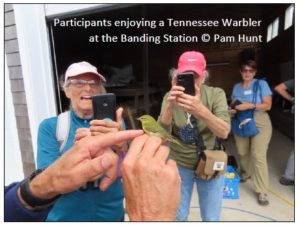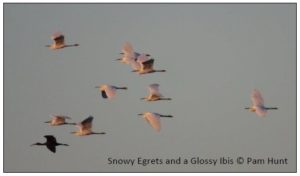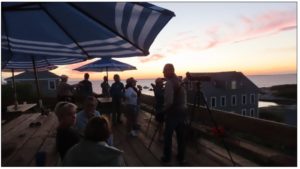(by Pam Hunt)
In early September, I was joined by trip co-leaders Becky Suomala (Trip 1) and Mark Suomala (Trip 2) and the wonderful crew at the Shoals Marine Lab led by Executive Director Jennifer Seavey, for a small-group birding experience at Appledore Island. Here are just a few of the highlights!

Among the obvious bird highlights were the evening and morning flights of Snowy Egrets (and the occasional Glossy Ibis) to or from their roost at the north end of the island. Trip 1 had the added bonus of an adult Yellow-crowned Night-Heron that perched in view long enough for everyone to get a good – if distant – look at it in the scopes. Another rarity was a Lark Sparrow seen by the banding station and again in the path to Broad Cove. This bird had been present for a few days but not seen recently, and was also not seen by Trip 2.

If you add in the banding station however, the number of warbler species rose to 15, and these and the other species captured in the nets were a big draw to many participants. Some of you even got to hold and release a bird after it had been processed! The Monarchs roosting in the White Poplar outside the banding station were another treat enjoyed by those lucky enough to be there Friday morning.
For both groups, when not birding, participants took in some of the educational options offered by the Shoals Marine Lab staff, including island history, sustainability, and a visit to Celia Thaxter’s garden with the official garden steward. And of course there were our evening programs on seabird restoration and bird migration. We certainly didn’t go hungry, and especially enjoyed our lobster bake on the Kiggins deck just before a nice sunset.

This trip enjoyed the sight of 240 egrets coming in against the darkening sky – an image we’ll not soon forget. Another highlight came on our boat trip around the islands, where in addition to excellent looks at seals, cormorants, and an adult Northern Gannet, we found a couple of banded American Oystercatchers on White Island. It turns out these were banded as chicks on nearby Lunging Island this summer, and the person who banded them was glad to hear they were still around.
The Appledore birding experience seems to be becoming an annual opportunity, so keep your eyes out for registration announcements for late summer 2023!
